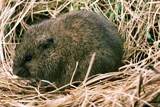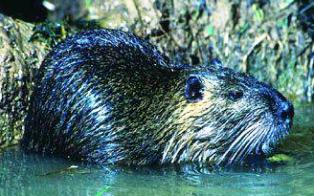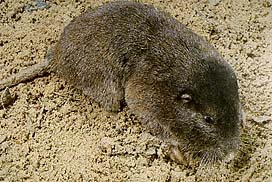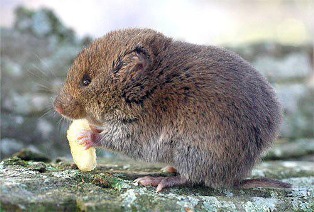Discover Florida Nature
It's time to explore the natural Florida


|
|
|
|
|
With over 2000 living species placed in about 30 families, rodents are
by far the largest order of mammals. Rodents range in size from the
pygmy mice to capybaras, the largest of which weigh over 150 pounds.
Some Florida rodents spend their entire lives above the ground in the
canopy of trees; others seldom emerge from beneath the ground. Some
species are highly aquatic, while others are equally specialized for
life in deserts. Many Florida rodents are to some degree omnivorous;
others are highly specialized, eating, for example, only a few species
of invertebrates or fungi. Meadow
Vole-
The Meadow Vole, or "Field Mouse," is a small, common rodent that lives
in grassy fields, woodland, marshes, and along lakes and rivers. It is
five to seven inches long, counting the tail, and usually weighs only
and ounce or two. Meadow Voles' color can vary from yellowish-brown to
reddish-brown to blackish-brown. They are normally gray on their
underparts. Meadow Voles make nests in clumps of grass, using materials
such as dry grass, sedges, and weeds. From their nests, they build
"runways," like tunnels beneath the grass and plants. Meadow Voles are
most active at night during the Summer, and during the day if its
Winter. They are less active when there's a full moon. Meadow Voles'
diet includes many things, including grasses, sedges, seeds, flowers,
leaves, roots of shrubs and small trees, bark, tubers, bulbs, and
sometimes insects. Most Meadow Voles live a year to a year and a half.
Meadow Voles breed frequently. It is common for a vole to have 12
litters a year. Anywhere between one and eleven young is normal. Meadow
Vole-
The Meadow Vole, or "Field Mouse," is a small, common rodent that lives
in grassy fields, woodland, marshes, and along lakes and rivers. It is
five to seven inches long, counting the tail, and usually weighs only
and ounce or two. Meadow Voles' color can vary from yellowish-brown to
reddish-brown to blackish-brown. They are normally gray on their
underparts. Meadow Voles make nests in clumps of grass, using materials
such as dry grass, sedges, and weeds. From their nests, they build
"runways," like tunnels beneath the grass and plants. Meadow Voles are
most active at night during the Summer, and during the day if its
Winter. They are less active when there's a full moon. Meadow Voles'
diet includes many things, including grasses, sedges, seeds, flowers,
leaves, roots of shrubs and small trees, bark, tubers, bulbs, and
sometimes insects. Most Meadow Voles live a year to a year and a half.
Meadow Voles breed frequently. It is common for a vole to have 12
litters a year. Anywhere between one and eleven young is normal. Round-tailed
Muskrat- Round-tail muskrats are distinguished from the muskrat
by two characters: they are noticeably smaller and have a round tail,
not a laterally compressed tail. The coarse outer fur of the
round-tailed muskrat is dark brown and glossy. The dense underfur is a
rich brown at the tip on the back and shifts to gray at the base, pale
buff belly. The round-tailed muskrat resembles a small muskrat, from 15
- 21.5 inches in total length. The tail is round instead of flattened on
the sides like muskrats. Round-tailed Muskrats inhabit freshwater
marshes in peninsular Florida and south-central and southeastern
Georgia. As many as 48 muskrats per hectare have been recorded in the
Everglades. They seem to prefer water about 12-18 inches deep.
Round-tailed muskrat construct roundish houses about 7 to 24 inches in
diameter at the surface of the water, with two underwater entrances that
are called plunge holes. The Muskrats are nocturnal and are most active
shortly after dark. The stems of aquatic grasses form the bulk of
round-tailed muskrat's diet. When water levels are low, muskrats can
burrow into wet mud and survive for a significant period of time.
Bobcats and some snakes and birds prey on
these rodents. Round-tailed
Muskrat- Round-tail muskrats are distinguished from the muskrat
by two characters: they are noticeably smaller and have a round tail,
not a laterally compressed tail. The coarse outer fur of the
round-tailed muskrat is dark brown and glossy. The dense underfur is a
rich brown at the tip on the back and shifts to gray at the base, pale
buff belly. The round-tailed muskrat resembles a small muskrat, from 15
- 21.5 inches in total length. The tail is round instead of flattened on
the sides like muskrats. Round-tailed Muskrats inhabit freshwater
marshes in peninsular Florida and south-central and southeastern
Georgia. As many as 48 muskrats per hectare have been recorded in the
Everglades. They seem to prefer water about 12-18 inches deep.
Round-tailed muskrat construct roundish houses about 7 to 24 inches in
diameter at the surface of the water, with two underwater entrances that
are called plunge holes. The Muskrats are nocturnal and are most active
shortly after dark. The stems of aquatic grasses form the bulk of
round-tailed muskrat's diet. When water levels are low, muskrats can
burrow into wet mud and survive for a significant period of time.
Bobcats and some snakes and birds prey on
these rodents.  Southeastern
Pocket Gopher-Pocket gophers are beautifully adapted for life
underground. These chestnut-colored rodents have small ears and eyes,
and can chew and dig their way through compacted soil and roots with the
help of large, incisor teeth and long, curved claws on enlarged
forelimbs. The lips close behind the front teeth, which prevents dirt
from entering the mouth. The "pocket" part of their common name refers
to two fur-lined cheek pockets or pouches, which have external openings
on either side of the mouth. The pouches are used to transport food and
nest material. Pocket gophers are only 10-12 inches long from nose to
tip of tail but they are capable of digging tunnel systems that may
extend for 500 feet or more, although 145 feet is the norm. As they dig,
they push piles of loose dirt to the surface, a characteristic that has
earned them the name "sandy mounders" or "salamanders." Shallow tunnels
generally run parallel to the surface and provide access to their diet
of roots and tubers, while nest and food storage tunnels are deeper.
Pocket gophers plug tunnel openings to prevent snakes and other
predators from entering. Pocket gophers are solitary animals and, except
for females nursing young, do not share a tunnel system. Southeastern
Pocket Gopher-Pocket gophers are beautifully adapted for life
underground. These chestnut-colored rodents have small ears and eyes,
and can chew and dig their way through compacted soil and roots with the
help of large, incisor teeth and long, curved claws on enlarged
forelimbs. The lips close behind the front teeth, which prevents dirt
from entering the mouth. The "pocket" part of their common name refers
to two fur-lined cheek pockets or pouches, which have external openings
on either side of the mouth. The pouches are used to transport food and
nest material. Pocket gophers are only 10-12 inches long from nose to
tip of tail but they are capable of digging tunnel systems that may
extend for 500 feet or more, although 145 feet is the norm. As they dig,
they push piles of loose dirt to the surface, a characteristic that has
earned them the name "sandy mounders" or "salamanders." Shallow tunnels
generally run parallel to the surface and provide access to their diet
of roots and tubers, while nest and food storage tunnels are deeper.
Pocket gophers plug tunnel openings to prevent snakes and other
predators from entering. Pocket gophers are solitary animals and, except
for females nursing young, do not share a tunnel system.  Woodland
Vole-
Woodland voles have a combined head and body length of between 83 and
120 mm; the tail ranges from 15 to 40 mm in length. They weigh between
14 and 37 grams. There is almost no sexual dimorphism within the
species. The dorsal region varies from light to dark brown in color. The
ventral surface is whitish or silvery. Their bodies have become modified
for their partially subterranean habitat by a reduction of the eyes,
external ears, and tail. Their foreclaws are also somewhat enlarged for
digging. Woodland voles live in deciduous forests in eastern North
America, including Florida. They are surface burrowers, moving through
thick leaf mold and loose soil. Woodland voles are surface burrowers,
normally going no deeper than 100 mm below ground. They may also use the
burrows of mice, moles, and large shrews. They are active at any time of
the night or day. There seems to be strong sociality between males and
females, and they are usually bonded in monogamous male-female pairs.
Mating generally takes place from spring through fall with a peak in
late spring to early summer. Some woodland voles may breed throughout
the year if they live at low altitudes or experience mild winters. About
21 days after breeding takes place, a litter of between 3 and 7 young is
born. The litter size can range from 1 to 13 newborns. Woodland
Vole-
Woodland voles have a combined head and body length of between 83 and
120 mm; the tail ranges from 15 to 40 mm in length. They weigh between
14 and 37 grams. There is almost no sexual dimorphism within the
species. The dorsal region varies from light to dark brown in color. The
ventral surface is whitish or silvery. Their bodies have become modified
for their partially subterranean habitat by a reduction of the eyes,
external ears, and tail. Their foreclaws are also somewhat enlarged for
digging. Woodland voles live in deciduous forests in eastern North
America, including Florida. They are surface burrowers, moving through
thick leaf mold and loose soil. Woodland voles are surface burrowers,
normally going no deeper than 100 mm below ground. They may also use the
burrows of mice, moles, and large shrews. They are active at any time of
the night or day. There seems to be strong sociality between males and
females, and they are usually bonded in monogamous male-female pairs.
Mating generally takes place from spring through fall with a peak in
late spring to early summer. Some woodland voles may breed throughout
the year if they live at low altitudes or experience mild winters. About
21 days after breeding takes place, a litter of between 3 and 7 young is
born. The litter size can range from 1 to 13 newborns.
|
|
|
Advertise | Privacy Statement | Dog Encyclopedia | Video |Contact | Alaska Nature |
|